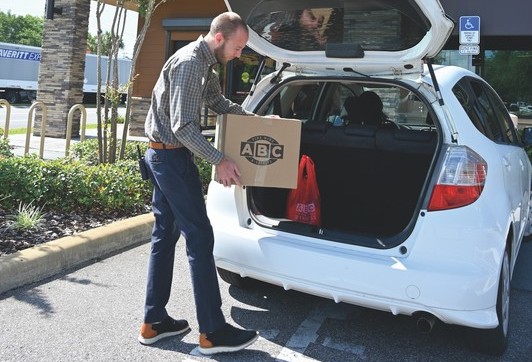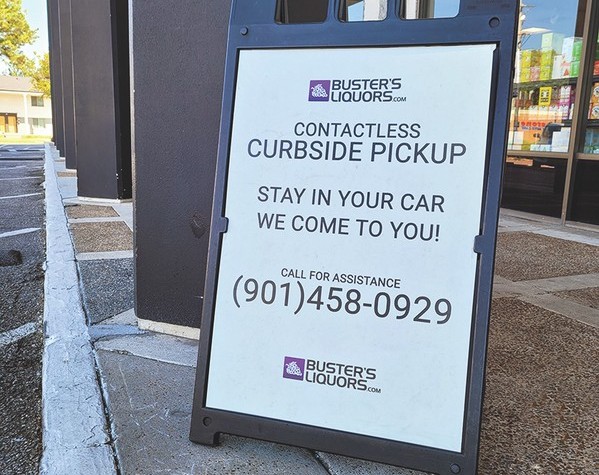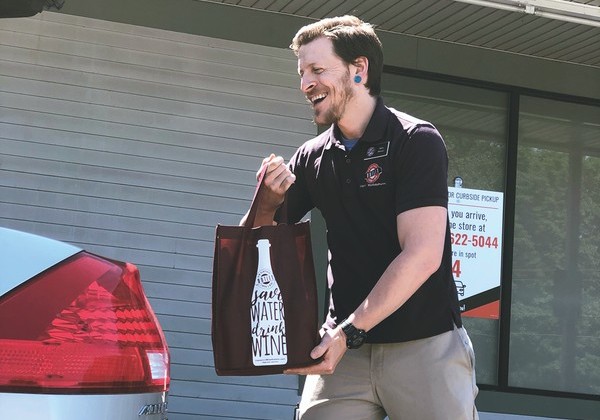
When the Covid-19 pandemic hit in 2020, Buster’s Liquors & Wines opted to close for in-store shopping to keep customers and employees safe. The Memphis, Tennessee store instead ramped up its e-commerce and curbside pickup services, and three years later, Buster’s hasn’t looked back. “We were servicing 700-800 customers a day with curbside pickup on Fridays and Saturdays,” says president and co-owner Josh Hammond. And while customers have returned to more traditional shopping habits these days, drive-up order retrieval remains popular. Hammond estimates that online sales now account for as much as 9% of the store’s sales, with most of the “last mile” facilitated through curbside pickup. “It’s become a big part of our business,” the retailer says.
At The Wine House in Los Angeles, curbside pickup has also emerged as a preferred option for many customers. With the store shut down to in-person shopping from March 2020 through May 2021, curbside pickup accounted for 80% of its transactions, according to owner Glen Knight. Today, about 20% of the store’s sales involve curbside pickup, Knight notes, and the service is particularly popular with regular customers who purchase upwards of 12 bottles at a time.
Indeed, in the aftermath of the pandemic, curbside and in-store pickup are still popular with consumers. While the services had been long established in retail channels like supermarkets and department stores, they’ve now become commonplace in wine and spirits shops around the country. Target even added drive-up and order pickup options for online sales of adult beverages in more than 1,200 stores in 2021. “Our adult beverage category is one of the fastest-growing divisions within our food and beverage business, and we continue to hear from guests how much they love our fast, easy, and safe same-day services,” says Rick Gomez, executive vice president and chief food and beverage officer at Target. “As we continue to invest in the products and experiences our guests love, making our wine, beer, and spirits selection available for pickup is a natural next step.”
Buy online, pickup in store (BOPIS), and curbside fulfillment services are likely to remain in demand for years to come. According to a recent study from the Associated Press-NORC Center for Public Affairs Research and the SCAN Foundation, 18% of adults over age 50 plan to continue utilizing curbside pickup post-pandemic, while a whopping 33% of those between 18 and 49 plan to do so.

Pandemic Impact
Not surprisingly, the pandemic sparked an explosion in BOPIS and curbside pickup services among beverage alcohol retailers. Florida’s ABC Fine Wine & Spirits launched its BOPIS service four years ago in all 125 stores, and according to CMO Sean Kelly, only one order was placed on day one. “Within a couple weeks, we had our first 100-order day,” he notes. Curbside services, meanwhile, started up in April 2020. “The guests’ response was immediately incredible,” Kelly says. “Online orders spiked by more than 2,000% initially, until guests felt more comfortable in public. Having curbside pickup created a lot more awareness to everything we offer and how much pre-shopping guests can do on our site. We feel that positive impact years later.”
In 2020, the New Hampshire Liquor Commission (NHLC) fast-tracked the rollout of curbside and in-store pickup at its 25 Liquor & Wine Outlets, and according to the commission, the services played “a critical role in NHLC generating record-breaking total sales of $801 million in fiscal year 2021.” Lorrie Piper, the commission’s director of sales, marketing, merchandising, and distribution, says of the services, “We’ve seen an overwhelmingly positive response from our customers. During the onset and through the height of the pandemic, customers appreciated the convenience of our in-store and curbside pickup services, and they continue to utilize those offerings as a regular shopping opportunity.”
At 1 West Dupont Circle Wines & Liquors in Washington, D.C., curbside pickup increased significantly during the pandemic, according to director of operations Prav Saroff. With in-store shopping suspended for more than three months, orders placed online and by phone were fulfilled via shipping, delivery, and curbside pickup. Saroff estimates that half of all orders were completed using the curbside option.

Counter Service
In Florida, ABC’s online platform allows shoppers to select the store from where they would like to purchase and see real-time inventory. For BOPIS orders, they immediately receive an email confirmation; then, usually 15-30 minutes later, another email telling them the order is ready for pickup. Guests can pick up the waiting package inside the store at a designated counter. In addition to the signage, Kelly notes that the chain added a special parking spot at each location for online shoppers “to help speed up the guest experience.”
At the New Hampshire state stores, in-store pickup orders of between two and 36 bottles are filled within 90 minutes during normal business hours. IPads and a proprietary lighting system aid employees in quickly fulfilling those orders. With NHLC’s in-store pickup system, special lights alert workers to the store’s online order volume, with a green light indicating one to five orders and a red light meaning more than ten orders. “We also have easy-to-see signage, making it simple for customers to know where to go to pick up an order when entering our outlets,” Piper notes.
Retailers say that the biggest benefit to BOPIS shopping is the convenience it provides to customers, which ultimately reflects well on the merchant. “Ordering online and utilizing our pickup services can be very convenient for those who already know what they want to purchase,” says Piper. Kelly agrees, saying, “our goal is to show up wherever our guests want to shop.” But on the flipside, as with all online shopping, BOPIS doesn’t offer consumers a hands-on shopping experience, nor the opportunity to engage with store staff about the merchandise.

Out To The Curb
As compared to in-store order fulfillment, curbside pickup generally requires a larger labor and space commitment from retailers. At the New Hampshire Liquor & Wine Outlets— where curbside orders can be collected as early as the next business day after ordering—designated parking spaces have been carved out, and signs with pickup instructions erected. Retailers in urban areas, such as Saroff in Washington, D.C. and Knight in Los Angeles, note that curbside pickup has made their stores more competitive with those that have parking lots, particularly when it comes to wooing customers with large orders. “In the past, we may have lost out on that business because we didn’t have a parking lot,” Saroff says. “But now people know they can bring their cars up front, and we’ll bring the product out to them. They don’t even have to get out of their cars.”
Hammond adds that the implementation of curbside pickup at Buster’s has proven lucrative for store employees. “Customers realize that unlike in-store shopping, there’s a higher level of service provided with curbside pickup, and they increasingly opt to tip,” the Tennessee retailer says. “It’s become a great source of added compensation for our workers.”
Still, for store operators, curbside pickup can put pressure on team members and labor costs. “It takes time to put the orders together, so it requires more staff,” Hammond notes. The Wine House’s Knight adds that when store traffic is busy, curbside pickup can be impacted. “If there are customers in line at the registers and the cashier is busy, sometimes there’s a small wait for customers in their cars,” he says. Similarly, ABC’s Kelly says that on busy days at his stores, it can be challenging to keep the designated curbside pickup parking spots available, which can slow down delivery of merchandise if “we have to run around the parking lot to find a guest.”
The ability to upsell customers is also lost with curbside pickup. “You lose the opportunity for impulse buys, upselling, and making recommendations,” Saroff concedes. “We’ve trained our staff that when someone buys a bottle of gin, ask if they need vermouth and tonic water too.” Hammond concurs that impulse sales can be impacted with the curbside service, but he says for Buster’s that loss has been negated with the overall increase in online orders.
Beverage alcohol retailers around the country universally agree that BOPIS and curbside pickup services will remain a part of the business way past the pandemic. “Our online ordering system and in-store and curbside pickup options will continue to provide a needed service to our customers,” says NHLC’s Piper. In fact, she adds, “We plan to continue looking for ways to improve the technology and to offer even more online services to provide the best service and experience for our customers.”
The fulfillment options are just the latest examples of how beverage alcohol retailers strive to provide superior customer service. While demand has settled down since the height of the pandemic, the services “remain essential for our guests and for ABC,” says Kelly. “It’s no longer a question of should we do this or should we keep this. We view BOPIS and curbside service as an absolute must.”